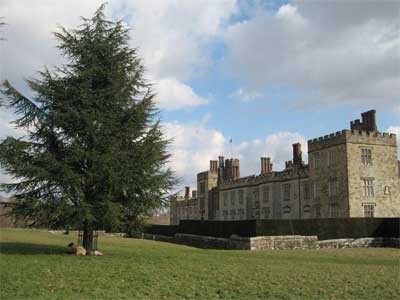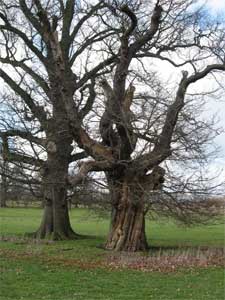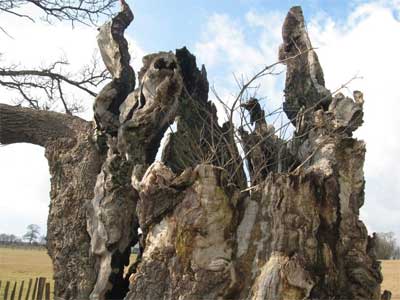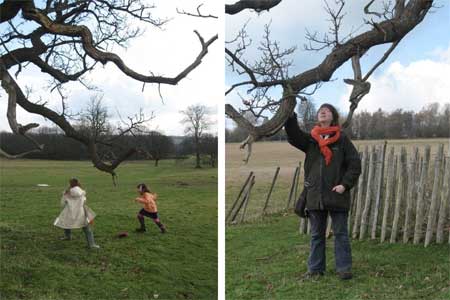Sidney’s millennium oak
By Ruth D’Alessandro, The Wildlife Gardener According to the saying, an oak tree’s life is: Three hundred years growing Three hundred years living Three hundred years dying Which means, metaphorically speaking, that the Wildlife Garden’s oak tree at about 175 years old, is only just experiencing adolescent pimples and hormones. But recently we went to visit an oak that had long since abandoned its Zimmer frame, and would be lucky if it sat in its wingback chair for very much longer.

Ah, the February half term. Possibly the longest week in the school calendar: inevitable rain, cold, nearly everything closed, many people off skiing (although quite why anyone would want to spend a fortune to stand around in MORE snow, or eat fondue…) you get the picture. In an attempt to get the Junior Wildlife Gardeners out for some apple-cheeking fresh air, we headed to Knole Park in Sevenoaks. Closed. Then we pointed the WGmobile in a straight line and headed to Penshurst. Aha! Penshurst Place in the Weald of Kent, the sprawling ancestral stately home of the Sidney family, set in ancient parkland.

Closed. But I remembered that there was a very old tree around there somewhere, and the lady in the (open) gift shop pointed us in the right direction for The Sidney Oak. So the Junior Wildlife Gardeners, who were by now tearing each other to shreds, could tear instead around acres of parkland while I indulged in one of my odder hobbies: visiting the ancient trees mentioned in Meetings With Remarkable Trees. The Sidney Oak was claimed by Ben Jonson to have been planted in 1554 at the birth of Sir Philip Sidney, the Elizabethan poet (Arcadia) and war hero (The Battle of Zutphen). However, Jonson’s reckoning was miles out and the tree in fact dated from the Middle Ages. Sir Philip apparently enjoyed sitting under this huge oak to write his poems about sheep, so it was a goodly 500 years old in Elizabethan times. Now, in 2010, Sidney’s oak is probably 1000 years old. We stumbled across an old, battered tree that looked promising, but my basic tree recognition skills identified this as a sweet chestnut, not an oak:

Heading round the lake, the unmistakeable ragged, blasted trunk of The Sidney Oak soon came into view. I felt an odd stab of pity for this venerable’vegetable’ that was clearly quite close to death. Its one living branch was propped, its trunk weirdly monolithic, a result of a long history of mishaps including being struck by lightning, breaking in half, and being set on fire by some children in the 1990s:

Yet buds could be seen on the branch as the tree creaked into life for 2010.

But for how much longer? Although The Sidney Oak itself is fading, the genes of this remarkable tree live on in its progeny; acorns from it were planted all over the world by well-travelled Sidney family members. Even more hi-tech: genetically-identical cloned saplings are to be planted around the Penshurst estate. Is longevity genetic? None of us will be here to find out. I love standing under ancient trees. It’s a peculiarly British pleasure. Few other places have so many trees of great age in such a small area; the UK has one of the highest proportions of ancient trees in Europe. Mainland Europe has a dearth of ancient trees because of its history of warfare and human displacement – big trees were destroyed or used for fuel. So an ancient tree in Britain -a’cathedral of the natural world’- is also symbolic of how fortunate we have been not to have experienced major wars on our soil. And that is something to be grateful for. So as I mused on luck and war, the Junior Wildlife Gardeners chased each other around under the Sidney Oak as did their Victorian, Elizabethan and Medieval forerunners. Some things never change.

- Spurn Spawn! - 26th February, 2014
- Bluebells on wheels: axles of evil? - 2nd February, 2011
- Raising the ba: Wildlife and the Ancient Egyptian Book of the Dead - 8th January, 2011

Can anyone tell me how to save this tree?
[URL=http://img27.imageshack.us/i/067ac.jpg/][IMG]http://img27.imageshack.us/img27/448/067ac.th.jpg[/IMG][/URL]
[URL=http://img232.imageshack.us/i/065dw.jpg/][IMG]http://img232.imageshack.us/img232/8781/065dw.th.jpg[/IMG][/URL]
[URL=http://img251.imageshack.us/i/064vb.jpg/][IMG]http://img251.imageshack.us/img251/1628/064vb.th.jpg[/IMG][/URL]
[URL=http://img710.imageshack.us/i/063pr.jpg/][IMG]http://img710.imageshack.us/img710/6929/063pr.th.jpg[/IMG][/URL]
Hi Steve, yes please – let us know how you get on.
Ruth, as with many trees in the book, it’s in private grounds (which is why they’ve survived etc etc).
My intention was to saunter in regardless, but I’ll see if I can find a contact number.
Aah, thanks Andii! Just when I think I’ve run out of subject matter something else interesting pops up, so shall keep posting.Will check your blog – love rural Ireland.
Hi Steve: The Fredville oak is next on my list of visits – I think I have to phone for an appointment?
Interesting post, Ruth. I like the idea of acorns being planted throughout the colonies by the Sydney family.
We have a ‘Remarkable Tree’ (it’s in the book) nearby, so will have to make a point of visiting it soon – the Fredville Oak, which is apparantly huge.
No doubt one day, however, it will be as sad as the Sydney tree.
Just love your stories!
I’ve just started a blog myself. It’s a surreal (and wacky?) glimpse into rural Ireland.
Keep posting!
Andii